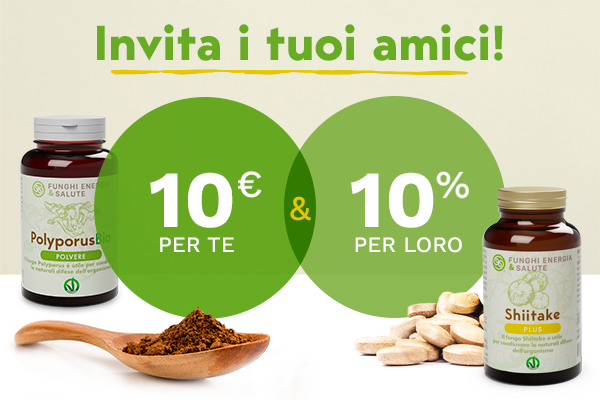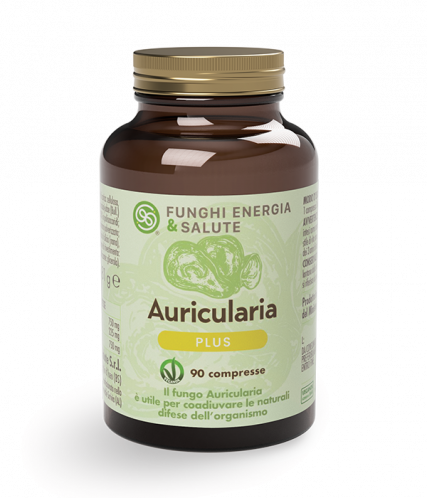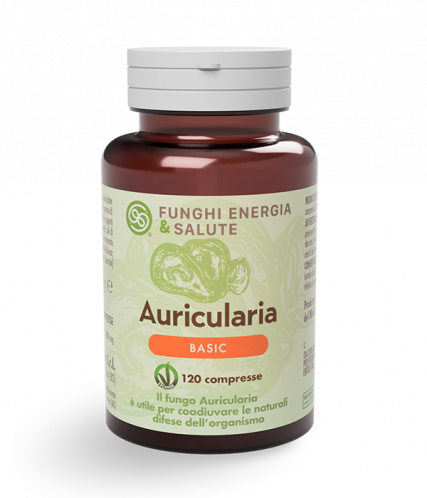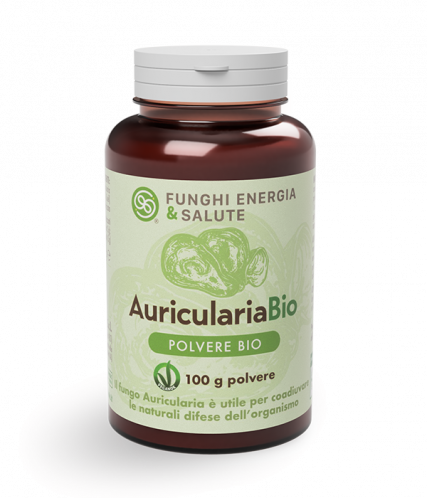Certified Natural products veganOK
030 9881073 Monday to Friday from 09:00 to 17:30


to get immediately a discount code
on your first purchase
Auricularia
- Home
- Auricularia
Auricularia (Auricularia auricula-judae) is a Medicinal Mushroom rich in adenosine, a molecule useful for our psychological well-being because it strengthens psycho-emotional functions and helps to counteract stress and anxiety.
Its documented vasodilator action allows:
- increased blood supply
- better oxygenation
- effective nourishment of the cardiac tissues
- precious support for all organs
- useful help for the circulatory system
- constant "cleaning" and prompt disposal of metabolic waste (Wu et al., 2010; Berne, 1980; Toda et al., 1982; Pelleg and Porter, 1990)
Adenosine is stored in all our cells but over the years it tends to decrease: to defend ourselves from possible inflammation we need to replenish our reserves of adenosine.
We can turn to nature and rely on Medicinal Mushrooms that contain this substance in abundance, such as Auricularia, Reishi and Cordyceps.
This Medicinal Mushroom has been widely used in Traditional Chinese Medicine for over a thousand years. The ancient Chinese and Japanese populations used it to assist in physiological intestinal functions.
In recent decades, interest in Auricularia has also spread among researchers from universities all over the world: many studies have been published in authoritative international journals, describing its benefits for well-being and health in detail. Hundreds of books in English, and a dozen in Italian too, written by experts, describe and disseminate the contents of this research.
Mycology
Very common on various broad-leaved trees, Auricularia (Auricularia auricula-judae) is a mushroom that never reaches large dimensions and is characterized by its particular shape, which resembles that of an ear.
Even if it prefers rainy and humid periods, it can be found throughout the year.
Among all Medicinal Mushrooms, Auricularia is the one that contains the highest concentration of adenosine. There are also beta-glucans, terpenes, polysaccharides of different types and AAP (Auricularia Auricula polysaccharides), as well as other nutritional substances such as vitamins, minerals and essential trace elements.
In detail:
- adenosine is an anti-inflammatory agent (Akkari et al., 2006) and vasodilator (Berne, 1980; Toda et al., 1982; Pelleg and Porter, 1990);
- beta-glucans are immunesystem stimulators and are anti-inflammatory (Ukai et al., 1983)
- terpenes are essential oils and immunostimulants;
- AAPs (Auricularia auricula polysaccharides) (Wu et al., 2010) are useful for the heart.
- Akkari R, Burbiel JC, Hockemeyer J, Muller CE. (2006): “Recent progress in the development of adenosine receptor ligands as antiinflammatory drugs.” Current Topics in Medicinal Chemistry, 6(13): 1375-1399.
- Berne RM. (1980): “The role of Adenosine in the regulation of coronary blood flow.” Circ. Res. 47: 807-813.
- Fan L, Zhang S, Yu L, Li M. (2006): “Evaluation of antioxidant property and quality of breads containing Auricularia auricula polysaccharide flour.” Food Chem, 101: 1158-63.
- Francia C, Rapior S, Courtecuisse R, Siroux Y. (1999): “Current Research Findings on the Effects of Selected Mushrooms on Cardiovascular Diseases”, in International Journal of Medicinal Mushrooms, 1, pp. 169-72.
- Pelleg A, Porter RS. (1990): "The pharmacology of adenosine." Pharmacotherapy: The Journal of Human Pharmacology and Drug Therapy, 10(3): 157-174.
- Toda N, Okunishi H, Taniyama K, Miyazaki M. (1982): “Response to adenine nucleotides and related compounds of isolated dog cerebral, coronary and mesenteric arteries”, in Blood Vessels, 19, pp. 226-236.
- Ukai S, Kiho T, Hara C, Kuruma I, Tanaka Y. (1983): “Polysaccharides in fungi. XIV. Anti-inflammatory effect of the polysaccharides from the fruit bodies of several fungi.” J Pharmaeobiodyn, 6(12): 983-90.
- Wu Q, Tan ZP, Liu HD, Gao L, Wu SJ, Luo JW, Zhang WZ, Zhao TL, Yu JF, Xu XH. (2010): “Chemical characterization of Auricularia auricula polysaccharides and its pharmacological effect on heart anti-oxidant enzyme activities and left ventricle ejection fraction in aged mice.” Int. J. Biol. Macromol., 46: 284-288.




